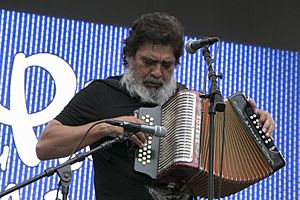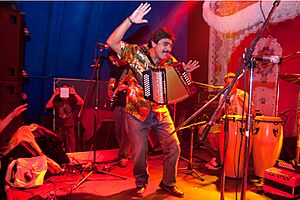Celso Piña facts for kids
Quick facts for kids
Celso Piña
|
|
|---|---|

Piña in 2012
|
|
| Background information | |
| Born | April 6, 1953 Monterrey, Nuevo León, Mexico |
| Died | August 21, 2019 (aged 66) |
| Genres | Cumbia |
| Occupation(s) |
|
| Instruments | Accordion
|
| Years active | 1980–2019 |
| Labels | La Tuna |
Celso Piña Arvizu (born April 6, 1953 – died August 21, 2019) was a famous Mexican singer and musician. He was known for playing the accordion and for his unique style of cumbia music. Cumbia is a lively dance music from Colombia.
Celso Piña was one of the first artists to mix traditional cumbia sounds with other music styles. He blended cumbia with reggae, ska, hip-hop, and more. People called him El Rebelde del acordeón (The Accordion Rebel) or the Cacique de la Campana (Chief of La Campana).
Contents
Celso Piña's Early Life
Celso Piña Arvizu was born on April 6, 1953, in Monterrey, Nuevo León, Mexico. His parents were Tita Arvizu and Isaac Piña. He was the oldest of nine children in his family. His grandfather chose the name Celso for him.
As a child and teenager, Celso worked many different jobs. He worked in a tortilla bakery, as a painter, and in mechanic shops. He also installed carpets. While working, he loved listening to music. He enjoyed groups like The Beatles and The Rolling Stones. He also liked Mexican norteña music.
Celso Piña's Music Career
Celso Piña's journey into music began in Monterrey. He first joined a group called Los Jarax. In this group, he played the maracas. But Celso really wanted to play the accordion. He also wanted to play different kinds of music.
Discovering Cumbia Music
In his neighborhood, La Campana, Colombian rhythms were very popular. Celso became interested in cumbia rebajada, a slower style of cumbia. A friend introduced him to famous Colombian artists. These included Aníbal Velásquez Hurtado and Alfredo Gutiérrez.
In the 1970s, Celso's father fixed an accordion for him. This allowed Celso to dive into Colombian music. He taught himself to play the accordion. He practiced a lot and developed his own special sound. He even wrote a cumbia song called Mi colonia Independencia about his neighborhood. His father also made other Colombian instruments for him.
Forming Ronda Bogotá
Celso decided to leave his job to focus on music full-time. His mother was not happy about this at first. But in 1975, he formed his own group, Ronda Bogotá. His brothers and sisters joined him. Celso sang and played the accordion. His brother Enrique played bass, and his sister Juana sang and played congas.
Ronda Bogotá played original music based on classic cumbia and vallenato. At first, people in Monterrey did not like their music much. Other music styles like tropical and norteño were more popular. But Celso and Ronda Bogotá kept playing their cumbia style. They wanted to offer something new to their city.
First Albums and Growing Fame
After trying to get a record deal, Ronda Bogotá met Felipe "Indio" Jimenez. He was an artistic director at Discos Peerless. In 1983, they released their first album, Si mañana. It included their first hit song, La manda. Other popular songs were La cumbia de la paz and La piragua.
Over time, record labels started to focus on Celso as the main artist. Albums were named Ronda Bogotá de Celso Piña and then Celso Piña y su Ronda Bogotá. By the late 1990s, Celso Piña was the most famous cumbia artist in Monterrey. His success led to other Colombian music groups forming. This made the music scene very busy, and Celso's group faced a quiet period.
Barrio Bravo and International Success
Around 2001, Celso Piña decided to try something new. He wanted to mix his classic cumbia sound with rock, ska, and hip-hop. This was part of a new music movement in Monterrey.
The result was his album Barrio Bravo in 2001. It was produced by Toy Selectah from the group Control Machete. This album featured many collaborations. Celso worked with famous Mexican rock artists like Rubén Albarrán from Cafe Tacvba. He also worked with Lupe Esparza from Grupo Bronco.
Barrio Bravo launched Celso Piña to fame across Mexico and Latin America. It included his biggest hits like Cumbia poder and Cumbia sobre el río. A famous writer, Carlos Monsiváis, even wrote about Celso for the album. He called Celso "a social phenomenon" and "a conductor of tribes." This album opened doors for more collaborations and big concerts for Celso.
In 2002, Celso released Mundo Colombia. This album also had many guest artists, including Julieta Venegas. Celso Piña toured many countries around the world. He visited Germany, Spain, Colombia, Canada, and the United States. In 2002, he was nominated for a Latin Grammy for Barrio Bravo.
In 2003, Celso played a concert in Monterrey that Gabriel García Márquez attended. They became friends. In 2010, Celso performed in Colombia for the first time. There, he met his musical heroes, Aníbal Velázquez and Alfredo Gutiérrez.
Celso Piña's Death and Legacy
On August 21, 2019, Celso Piña passed away from a heart attack in Monterrey, Mexico. He was 66 years old. He went to the hospital because he felt unwell and died shortly after.
Many people honored Celso after his death. A special mass was held in his memory. Hundreds of fans came to pay their respects. His casket was driven through his old neighborhood one last time. A concert was held in Monterrey to celebrate his music. Many artists performed, including El Gran Silencio.
Murals with Celso's image were painted in his neighborhood. The Monterrey government has also talked about naming a street after him.
Celso Piña's Albums
|
|
Source: AllMusic.
See also
 In Spanish: Celso Piña para niños
In Spanish: Celso Piña para niños


